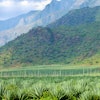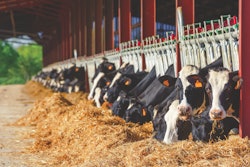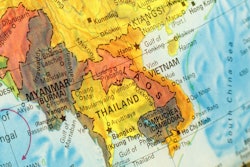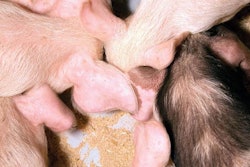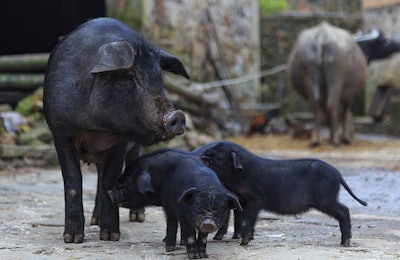
South Korea reports disease at 5 locations in past week
Over the past week, there have been official reports of five new outbreaks of the African swine fever (ASF) in South Korea — including three on commercial farms — and nine village herds have been affected in Laos. There have also been further cases in Russia’s Far East.
With the country’s first cases of ASF confirmed just three weeks ago, South Korea’s animal health agency has officially reported cases of the pig disease at five locations over the past week.
The latest outbreaks reported by the Republic of Korea’s agriculture ministry to the World Organisation for Animal Health (OIE) all occurred in Gyeonggi province in the northwest of the country, between the capital city of Seoul and the border with North Korea. Affected were three farms and one backyard herd in the city regions of Paju and Gimpo. Of the more than 7,500 pigs directly affected, there were 14 clinical cases, and five animals died.
These latest cases bring the country’s total direct losses since September 16 to almost 23,000 pigs through mortality or culling, based on the official OIE reports.
On October 2, the ASF virus was detected in one wild boar found dead in the Demilitarized Zone (DMZ) between the Republic of Korea and its northern neighbor near Yeoncheon county, according to Yonhap. The report says offers from the Seoul government to carry out joint disinfection measures in the DMZ have received no reaction from Pyongyang, and that there have been no reports on the ASF situation in North Korea since May.
The news agency recently confirmed a new ASF outbreak at a farm in Yeoncheon, which prompted a 48-hour ban on all pig movements in the town. Before this latest outbreak — the country’s 14th in domestic pigs — about 150,000 pigs had been culled by the South Korean authorities in efforts to control the spread of the disease.
9 new ASF outbreaks confirmed in Laos
OIE has been informed of nine new outbreaks of ASF by the agriculture ministry of Laos. Based on these official reports, the country’s totals since June have reached 151 outbreaks, and losses of almost 30,000 domestic pigs.
Reports cover outbreaks starting between August 27 and September 19 in three broad regions of the country, all in village pig herds. Worst affected in terms of new outbreaks is the south of the country, where there have been four recent outbreaks involving 1,514 animals in the provinces of Attapeu, Champasak and Sekong. There have been three new ASF outbreaks in central Laos, in and around the capital Vientiane, where 478 pigs were lost to the disease through mortality or culling. Two further village herds totaling 1,850 pigs were almost wiped out by the disease in the central province of Xiengkhong.
Further cases in Russia’s Far East
There have been six new outbreaks of ASF among domestic pigs in the Far Eastern Federal District, according to the latest report from Russia’s agriculture ministry to the OIE. These led to the loss of a more than 230 pigs. Affected were three backyard herds in Yevreyskaya (Jewish Autonomous Oblast), along with one village herd and two backyards in Primorsky krai.
In addition, the report outlines, nine wild boar found dead at one location in Primorsky in early August also tested positive for the ASF virus.
Since the first ASF cases at a small farm in the District at the end of July, there have now been 38 outbreaks involving more than 2,360 animals.
More pigs culled in the Philippines
No official reports of new outbreaks in the Philippines have been lodged with the OIE since the Immediate Notification one month ago. However, local media report further culling of pigs in efforts to halt the spread of infection.
These included almost 1,200 animals at farms at two towns in the province of Bulacan in Central Luzon, reported the Philippines News Agency (PNA) last week. Evidence of the ASF infection came from blood samples taken from the herds during September.
Around 12,000 more pigs have recently tested positive for the ASF virus, reports ABS-CBN. According to the Department of Agriculture, these animals are located in 20 districts in the provinces of Rizal, Bulacan, Pampanga, and Quezon City — all on Luzon.
Elsewhere in the Philippines, the Iloilo City government has put a 90-day ban in place on the entry of all live pigs, carcasses, pig meat and pork products from all countries where ASF has been detected, according to the latest report from PNA. The mayor justified the ban as a means to protect pig producers in Western Visayas, adding that the city is an important trading hub for the region. An information campaign has been initiated in the area, informing the local population of ASF risks to pigs, while stressing that pork is safe to eat.
Concerns over a drop in pork consumption in the Philippines are well founded. Demand is down by 30%, according to the National Federation of Hog Raisers, reports ABS-CBN, while ASF has claimed less than 1% of the country’s pigs. Of the nation’s 12.7 million pigs, only 20,000 have been culled to stop the spread of the disease. Around two-thirds of the culls were slaughtered because they were kept within 1 kilometer of a known outbreak, a spokesperson for the Federation said.
Vietnam plans pork supplies for 2020 Lunar New Year
Authorities are already taking measures to ensure there will be no shortages of key food supplies for next year’s Lunar New Year (Tet) celebrations. Hanoi already has stores of 44,600 metric tons of pork, reports Vietnam News.
The most recent official report on the ASF situation sent to the OIE from the country’s agriculture department was at the end of August. The disease has been reported in all areas of the country, and more than 5 million pigs have been culled. Developments have ceased to be covered by local English-language media.
View our continuing coverage of the African swine fever outbreak.

